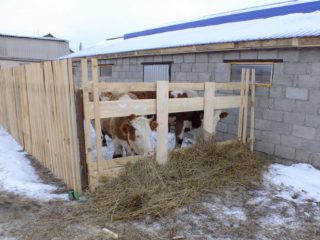Content
Keratoconjunctivitis in cattle develops quickly and affects most of the herd. Exacerbations occur in the summer-autumn period and cause damage to the farm, since recovered animals remain carriers of the infectious agent. That is why it is necessary to recognize keratoconjunctivitis in time and begin its treatment in cattle.
Causes of keratoconjunctivitis in cattle
In cattle, infectious and invasive keratoconjunctivitis is most common. These diseases have similar symptoms, but their causes are different.
Infectious keratoconjunctivitis is an acute disease of the visual organ, accompanied by inflammation of the cornea and conjunctiva. It occurs spontaneously and affects up to 90% of the herd. The main cause of the occurrence and spread of the disease is the weakened immunity of cattle. In winter, the infection is transmitted through direct contact of animals with each other. In the hot season, insects contribute to this.
Other causes that cause infectious keratoconjunctivitis include:
- depletion of the herd due to poor quality feed;
- lack of vitamins and minerals;
- high concentrations of ammonia in pens;
- unsanitary conditions in the barnyard, accumulation of manure.
All these factors lead to the fact that the body's natural resistance is reduced.He becomes vulnerable to various kinds of infections.
The root cause of invasive keratoconjunctivitis is helminths. The most common causative agent is thelasia nematodes. There are more than 32 species of this helminth; each individual animal may have different larvae. They settle in the conjunctival sac and cause inflammation. They live up to 10-11 months, after which they leave the eye, and young individuals appear in their place.
Against the background of invasive conjunctivitis, purulent inflammation develops, so the disease is often called mixed. Moreover, the first cause of its occurrence is parasites, and microbes are secondary inflammation.
Symptoms of keratoconjunctivitis
Symptoms of infectious bovine keratoconjunctivitis are most often similar to catarrhal conjunctivitis or keratitis with ulceration. Only a few animals tolerate it mildly without corneal damage. The incubation period lasts from three to 11 days. In total, the disease in cattle lasts up to one and a half months. However, in more complex cases, recovery takes up to 50-55 days. All this time, the body temperature of the cattle remains slightly elevated, but the general condition is depressed.
The main symptoms of infectious keratoconjunctivitis include:
- lethargic condition of cattle;
- a sharp decrease in appetite;
- significant weight loss;
- slow growth of young animals;
- reduction in the quantity and quality of milk;
- swelling of the conjunctiva;
- lacrimation;
- spasm of the eyelids.
As the disease progresses, the swelling of the conjunctiva intensifies, it becomes red, the eyelids swell, and they are painful when pressed. Purulent secretion is discharged from the eyes.After a few days, changes occur in the cornea. It softens and pus is observed. Externally, this is manifested by clouding of the cornea. Later, abscesses form, which spontaneously burst and turn into ulcers. As a result, complications arise that lead to complete blindness.
Invasive keratoconjunctivitis is manifested by severe lacrimation and spasm of the eyelids. After a few days, the inflammation intensifies, as does the mucous discharge, as a result the eyelids stick together with this mucus. Gradually, the secretion becomes purulent, the cornea becomes cloudy, thickens and disintegrates. A large ulcer forms in the center, and complete atrophy of the eye occurs. The clinical picture is very similar to infectious bovine keratoconjunctivitis, which makes diagnosis difficult. To accurately recognize the disease, you need to conduct an analysis and examine the contents of the conjunctival sac. Adult helminths or their larvae are found in it.
Treatment of keratoconjunctivitis in cattle
Treatment of infectious keratoconjunctivitis in cattle is complicated by massive damage to the herd. Today, specific treatment methods are unknown. Many veterinarians offer symptomatic therapy, which consists of washing the conjunctival sac with antiseptic solutions and applying ointments. In some cases, penicillin injections are prescribed intramuscularly. This antibiotic gives the best results.
Treatment of invasive keratoconjunctivitis is primarily aimed at eliminating secondary infection. The helminths and their larvae are removed from the conjunctival sac and washed with an antiseptic solution and boric acid. Further, treatment is continued based on symptoms.
Prognosis and prevention
After recovery, complete restoration of vision is possible only occasionally, if the infection has not led to corneal atrophy. In most cases, the cattle remain blind.
It has been noted that the speed of recovery is influenced by the conditions of detention and the time of year. In summer, the disease spreads faster and is more difficult to tolerate; complications most often arise.
To avoid an annual outbreak of the disease, you need to devote enough time to preventive measures. The livestock is inspected once a month, all affected animals are isolated.
The premises where livestock are kept are regularly disinfected, feeders, drinking bowls and all equipment are washed and cleaned. During the hot season, do not allow flies and other carriers of parasites to accumulate indoors. In addition, it is necessary to carry out deworming on time. Manure is kept separately from animals in specially prepared places, sprinkled with bleach.
Conclusion
Keratoconjunctivitis in cattle is a dangerous disease that leads to complete blindness in the herd. The causes of its occurrence are different, so there is no identical treatment regimen. To avoid damage, you need to carry out preventive procedures on time and keep the cattle clean.











